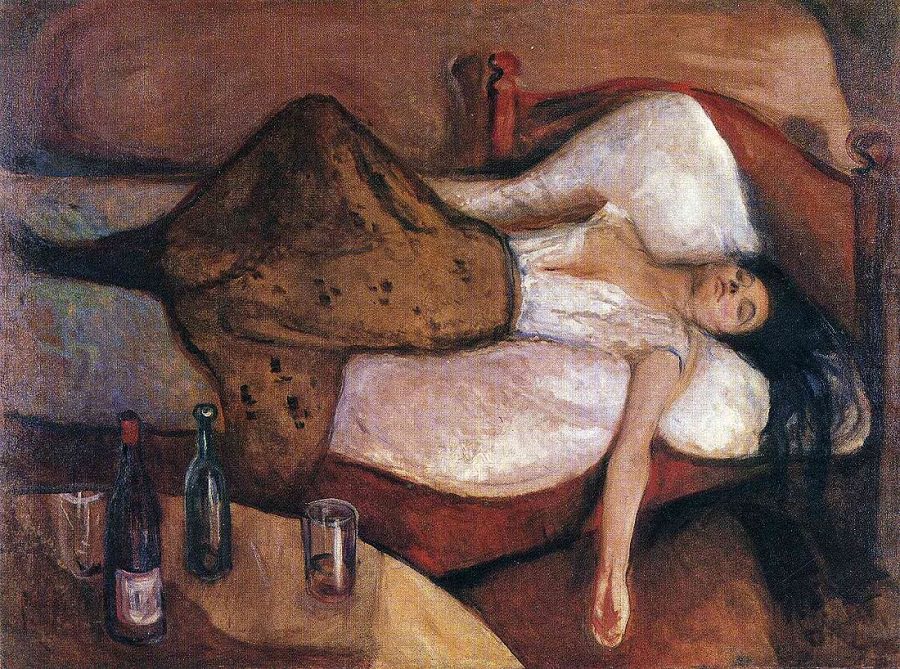
What is the Meaning of The Day After Painting by Edvard Munch
Edvard Munch, the Norwegian painter most famously known for The Scream, created a haunting and introspective body of work that explored themes of existential dread, human psychology, love, death, and melancholy. Among his lesser-known but profoundly evocative paintings is The Day After (Dagen derpå, 1894–1895), a striking piece that, like many of Munch’s works, defies superficial interpretation and instead invites viewers into a deeper engagement with the human psyche.
This article delves into a comprehensive analysis of The Day After, what the painting is about, how it was created, the symbolism it carries, its place within Munch’s broader oeuvre, and where it resides today.
What is The Day After Painting by Edvard Munch All About?
The Day After presents a moment of quiet despair and reflective aftermath. The central subject of the painting is a woman, lying languidly on a disheveled bed, her head tossed back, hair undone, with a blank or possibly pained expression on her face. She is dressed in a corset or some undergarment, suggestive of a night spent in intimacy, possibly drunkenness or even regret.
Munch paints a scene not of the passionate act itself but its emotional consequence. The title immediately suggests a temporal framing, the morning after an intense or dramatic event, likely a pleasure in nature, and possibly transactional. The moment is emotionally charged, heavy with consequences, emptiness, or even shame. This theme of emotional and psychological aftermath is quintessentially Munch, who often explored human vulnerability in raw, unidealized ways.
Who and How Was It Painted?
Edvard Munch painted The Day After around 1894–1895, a period during which he was actively producing works for what he termed “The Frieze of Life.” This thematic series examined love, anxiety, jealousy, illness, and death. The series included paintings like The Kiss, Anxiety, Madonna, and Ashes, all focusing on intense emotional experiences.
The woman in The Day After is possibly modeled after one of Munch’s real-life acquaintances or lovers. Munch had several complicated relationships with women throughout his life, his love life was filled with longing, suspicion, fear of entrapment, and ultimately solitude. The female figure here might be drawn from his own encounters, but like many of Munch’s figures, she transcends a specific identity and comes to represent a broader archetype: the femme fatale or the vulnerable woman coping with societal judgments and emotional consequences.
Technically, Munch painted this work using oil on canvas. His brushwork is fluid and expressive, typical of his style during the 1890s. He employed soft contours and moody, muted tones to create an atmosphere that feels dreamlike and somber. The color palette, faded reds, dull whites, and deep browns, supports the mood of exhaustion and disillusionment. The light streaming in from the side of the canvas, possibly from a window, contrasts with the interior darkness, suggesting the cold, unwelcome reality of daylight intruding on a troubled private moment.
Symbolism and Psychological Depth in The Day After
One of the most compelling aspects of The Day After is its dense symbolism. Every element of the painting contributes to a narrative of emotional fallout and existential questioning.
1. The Woman’s Posture
The reclining pose of the woman, with her limbs relaxed and head thrown back, is both sensuous and lifeless. It suggests surrender, not only physical but emotional. This pose can evoke various interpretations: fatigue, abandonment, post-coital vulnerability, or a depressive stupor. Munch doesn’t show the intimate body; instead, he captures the complex emotions associated with it.
2. The Bed
The unmade bed, with tangled sheets and a displaced pillow, is a powerful symbol in Munch’s work. It recurs in other paintings like Ashes and The Sick Child, representing everything from illness and death to intimacy and aftermath. Here, it encapsulates the setting of a private act that has resulted in emotional upheaval. The bed is not a place of comfort but of exposure and despondency.
3. Light and Shadow
The interplay of light and shadow further adds to the psychological tension. The intrusion of daylight symbolizes reality crashing into a moment that might have been fleeting or illusory. Morning brings with it a sobering clarity, one that exposes regrets and raw truths.
4. Emotional Aftermath
The title itself, The Day After, implies consequences. Munch often painted not the events themselves but their emotional reverberations. Whether the act was consensual, romantic, transactional, or even coerced is left ambiguous. The psychological reality, however, is clear: what is being shown is the consequence of emotional risk, of passion unmoored from stability, of longing met with regret.
The Themes of Alienation and Despair
A broader reading of The Day After places it squarely within the Symbolist tradition of the late 19th century. Symbolist painters and writers aimed to depict internal realities rather than external appearances. For Munch, who was influenced by both Symbolism and early Expressionism, the visible world was just a surface. Beneath it seethed a complex matrix of emotions, instincts, fears, and longings.
In this painting, the woman is both physically and emotionally isolated. She occupies a confined, claustrophobic space, and the emotional resonance of the scene is one of solitude and disconnection. It speaks to broader themes that haunted Munch: the emotional distance between people, the cost of love, the vulnerability of women in a patriarchal society, and the inexorable presence of despair in human life.
This emotional alienation would become a key motif in modernist art, and Munch was one of its early heralds.
What Type of Art Is The Day After?
The Day After is often classified under Symbolism, with strong leanings toward Expressionism, the movement that Munch would later become a central figure in. Symbolist artists aimed to convey inner truths, emotions, and psychological realities rather than depict the external world with realism or naturalism.
What sets Munch apart is his ability to merge Symbolism with a proto-Expressionist intensity. His lines are not about precision but feeling. His use of color is not about beauty but mood. His figures are not posed but exposed. The Day After is less a portrait of a woman and more a portrait of emotional desolation.
Additionally, the painting carries autobiographical elements. Munch’s own life was marred by trauma: the early deaths of his mother and sister, his turbulent relationships, and his own struggles with mental illness. He poured this psychic pain into his art, and The Day After is a vivid example of that artistic alchemy.
What Is Happening in The Day After Painting?
At a narrative level, the painting captures a woman alone in her bedroom, presumably after a night of drinking and making love. However, as with most of Munch’s work, the literal action is less important than the emotional state conveyed.
This is a moment of aftermath, an interstitial period between night and day, between action and reflection. The woman’s expression is difficult to read, it might be vacant, resigned, sad, or even numb. That ambiguity is deliberate. Munch resists the didactic or moralistic and instead presents a psychological snapshot.
Many scholars interpret this scene as a representation of the emotional cost borne by women in a society where their intimate pleasure was both fetishized and condemned. In this sense, The Day After becomes a feminist painting, not in a celebratory way, but as a stark confrontation with gendered emotional labor and double standards.
Where Is The Day After Painting Located Today?
The Day After is housed in the Munch Museum (Munchmuseet) in Oslo, Norway. The museum is the primary repository of Munch’s art and contains over half of his known works, thanks to a generous bequest he made before his death in 1944. The museum moved to a new, modern building near the Oslo waterfront in 2021, which provides a stunning and fitting backdrop for the emotional and visual intensity of Munch’s oeuvre.
Visitors to the Munch Museum can experience The Day After alongside many of his other paintings in “The Frieze of Life” series. Seeing the works together allows for a deeper understanding of Munch’s recurring themes and artistic evolution.
Why The Day After Still Matters
The Day After is not as famous as The Scream, but in many ways, it is just as emotionally impactful. It invites a slower, more introspective kind of viewing. It captures the psychological wreckage that can follow intense human connection, the emptiness, the alienation, the vulnerability. It shows us a woman who is not defined by beauty or youth, but by her emotional truth.
In a world still grappling with issues of gender, emotional expression, and the mental toll of intimacy, The Day After remains relevant. It is a quiet painting, but one that reverberates with emotional intensity.
Munch’s brilliance lay in his ability to strip away societal pretenses and portray the bare, often uncomfortable truth of human experience. The Day After is a testament to that vision, a painting about regret, aftermath, and the heavy silence that follows life’s most passionate moments. It is a painting that doesn’t just ask to be seen, it asks to be felt.




